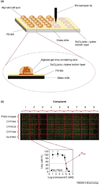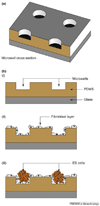High-throughput cellular microarray platforms: applications in drug discovery, toxicology and stem cell research
- PMID: 19398140
- PMCID: PMC5333994
- DOI: 10.1016/j.tibtech.2009.02.009
High-throughput cellular microarray platforms: applications in drug discovery, toxicology and stem cell research
Abstract
Cellular microarrays are powerful experimental tools for high-throughput screening of large numbers of test samples. Miniaturization increases assay throughput while reducing reagent consumption and the number of cells required, making these systems attractive for a wide range of assays in drug discovery, toxicology, stem cell research and potentially therapy. Here, we provide an overview of the emerging technologies that can be used to generate cellular microarrays, and we highlight recent significant advances in the field. This emerging and multidisciplinary approach offers new opportunities for the design and control of stem cells in tissue engineering and cellular therapies and promises to expedite drug discovery in the biotechnology and pharmaceutical industries.
Figures



References
-
- Kwon SJ, et al. High-throughput, microarray-based synthesis of natural product analogues via in vitro metabolic pathway construction. ACS Chem. Biol. 2007;2:419–425. - PubMed
-
- Geysen HM, et al. Combinatorial compound libraries for drug discovery: an ongoing challenge. Nat. Rev. Drug Discov. 2003;2:222–230. - PubMed
-
- Klimanskaya I, et al. Derive and conquer: sourcing and differentiating stem cells for therapeutic applications. Nat. Rev. Drug Discov. 2008;7:131–142. - PubMed
-
- Sartipy P, et al. The application of human embryonic stem cell technologies to drug discovery. Drug Discov. Today. 2007;12:688–699. - PubMed
-
- McNeish J. Embryonic stem cells in drug discovery. Nat. Rev. Drug Discov. 2004;3:70–80. - PubMed
Publication types
MeSH terms
Grants and funding
LinkOut - more resources
Full Text Sources
Other Literature Sources
Medical

